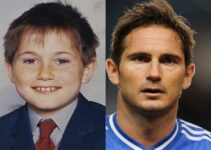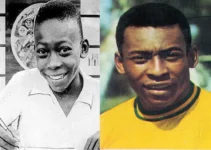Football has rarely seen a player revered like Diego Maradona, a figure worshipped as a god during his active days on the pitch. If you’re unfamiliar with his story, you might be new to the tales of classic legends. Maradona was more than just a talented footballer; he was the greatest of his generation, a player whose life intertwined with both extraordinary success and significant controversies.
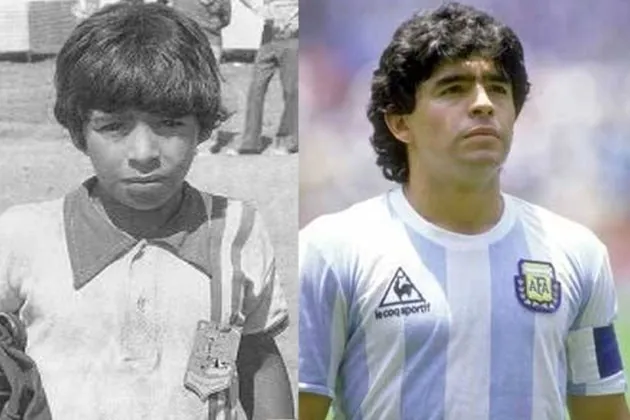
Journey of Diego Maradona: From Humble Beginnings to Football God
In this biography, you’ll discover the life of this Argentine legend, starting from his humble beginnings, exploring his family dynamics, and tracing his early career. We’ll delve into the pivotal moments of his career, alongside the off-pitch challenges that shaped him. Despite facing numerous controversies and health struggles later in life, Maradona remained a beloved icon, celebrated for his immense contributions to football and his indomitable spirit. His legacy continues to resonate, marked not only by his achievements on the field but also by the profound impact he had on fans around the world.
So, without further ado, let us embark on the journey of Diego Maradona’s life and career.
Diego Maradona Childhood Story – Early Life and Family Background:
To start his biography, Diego Armando Maradona was famously nicknamed the ‘Cosmic Kite.’ He was born on October 30, 1960, in Villa Fiorito, a poor neighbourhood in Buenos Aires, Argentina. His parents were Don Diego, his father, and Dalma Salvadora Franco, his mother.

A rare childhood photo of Diego Maradona.
He was born as the fifth out of eight children to a Roman Catholic family. Maradona’s first name has its origins in Greek and Hebrew.
It means either a supplanter (to take the place of another) or a teacher. His middle name is Armando – it means “man in the army.”
Maradona grew up in his impoverished but close-knit household neighbourhood of Villa Fiorito. His family was among the poorest in town being that they had larger numbers.
Diego’s father, Don Diego, was a bricklayer and factory worker who struggled to provide for three heavy-duty boys, five girls, and his stay-at-home housewife, Dalma.
Poverty, however, wasn’t a deterrent to success. Maradona’s first contact with soccer came when he was given his first soccer ball gift by his cousin, Beto Zarate.
This happened on his third birthday. Young Diego slept with the ball inside his shirt for nearly six months to avoid it being stolen.
This ball was sometimes seized by his mother, who wanted him to concentrate on his studies in other to be a professional accountant.
It didn’t much time before she finally realized football was his calling.

The early footballing years of Diego Maradona.
He took a liking to football at a relatively young age.
By the age of nine, he had learned to play soccer. His first contact with a full football play came when he was told to join his village team named “Little Onion”.
While he was with the Little Onions, he led his team to win 140 straight games.
Diego Maradona quickly rose through the ranks as a child, thanks to his exceptional dribbling, powerful assists, precise passes, and remarkable footwork. Audiences were in awe as they watched this small boy effortlessly weave past much taller opponents, leaving everyone astonished by his talent.
It didn’t take long before a football news outlet published an article that said, “There was a kid with the attitude and talent of a star”, although they misspelt his name “Caradona”.
Diego Maradona Family Life:
In this section, we’ll tell you about members of Diego Maradona’s household. Let’s start with his Dad.
Diego Maradona’s Father:
His name is Diego Sr, and he was born in Esquina, a city in Argentina. For many years, Diego Maradona’s Dad earned a living transporting passengers by boat, which he rode on the Argentine waters.
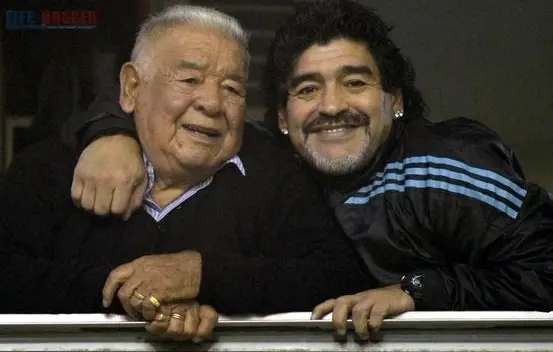
A heartwarming photo of the late Diego Maradona and his Dad, Diego Sr.
Many have regarded him as the man who forged Diego’s dreams. Diego Sr made great financial sacrifices at the start of his son’s career.
He worked endless hours in a factory to see his son through. Diego Sr knew his son’s importance to Argentine football was crucial. This was why He and his wife never missed any of the son’s games.
“The person who most wanted him to triumph was me. I shined his boots, and I thought that he could overtake Pele or if he was better. As time went on, Pele left my mind,” he said.
The father was also present on the most important day of Maradona’s life when he converted both goals in that controversial 2-1 victory over England in the World Cup quarter-finals in 1986.
“Nobody saw the goal with his hand, not even I. It was such a little handball that when they replayed it over and over, it seems he pulled out his hand more.”
Maradona’s Dad also had to suffer through his son’s problems with addiction and health troubles but always maintained that Diego was “an excellent, special son”.
“He gives me an unbreakable pride because a kid that came out of the mud there, for the whole world to remember him, is priceless.” He was a close friend to everyone, including Lionel Messi.
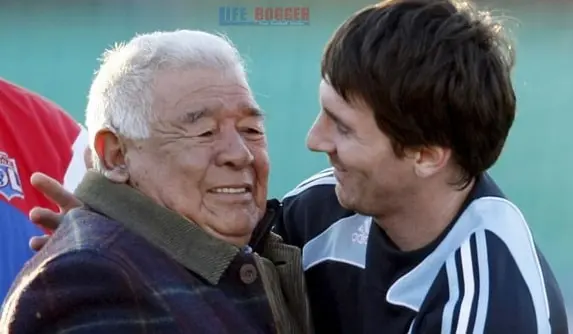
Don Diego, the father of football legend Diego Maradona, has passed away after a month of being hospitalized. Reports indicated that he battled respiratory and heart problems. The figure was 87 years old when he died.
He was married to Dalma Salvadora Franco and had eight children, namely Ana, Rita (Kitti), Elsa (Lili), María Rosa (Mary), Raúl (Lalo), Hugo (Turco) and Claudia (Cali), as well as course Diego Armando, “Pelusa”.
Diego Maradona’s Mother:

Truth be told; no other individual or event has had a greater effect than Dalma Salvadora Franco, better known as ‘Dona Tota’, on the career and life of her son.
This reverence is a fitting tribute for the woman who, more than anybody else, fought to keep her son on the right path, even though, at times, it seemed an impossible task.
It is difficult to overstate the impact of ‘El Diego’s mother on making him the man he is today.
However, in the past 35 years, Maradona himself has often tried to explain the sacrifices and efforts made by his mother to protect him and his five siblings in the peripheral Buenos Aires shantytown of Villa Fiorito. Here is one of his heartfelt words for his mother.
“At 13 years old, I realised that my mother had never suffered a stomach ache,” Diego would begin, recalling one of his favoured anecdotes about his mother’s protective instincts.
“She never had a stomach ache, she just wanted us to eat. Every time the food would come out, she would say ‘my stomach hurts’.
What a lie! It was because there was not enough to go around. That is why I love my old lady so much.”
His mother was there for him at every stage of his career. She would leave the rest of her children to stay with Diego.
While staying with him, she fought him severally as regards controlling his drug addict lifestyle to a 0 minimum.
She was the reason why Maradona didn’t retire early due to drugs. Maradona dealt with his smoking habit while with her. He could only manage vapour e-cigarettes.
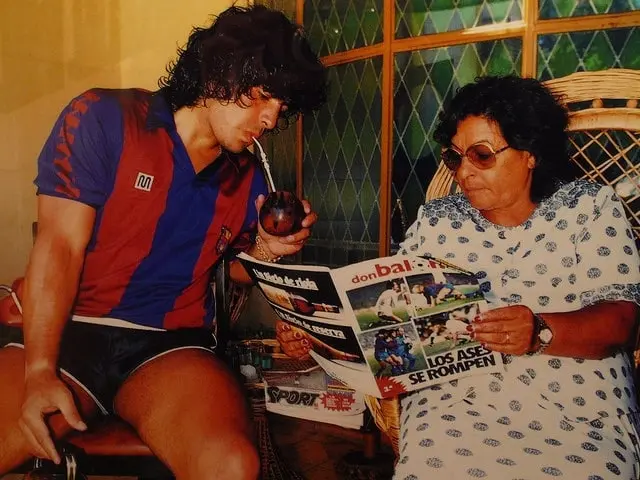
Maradona loved his mother so much that he could kiss her even in the glaring eyes of the public in a bid to feel her motherly love. This many people weren’t comfortable about.
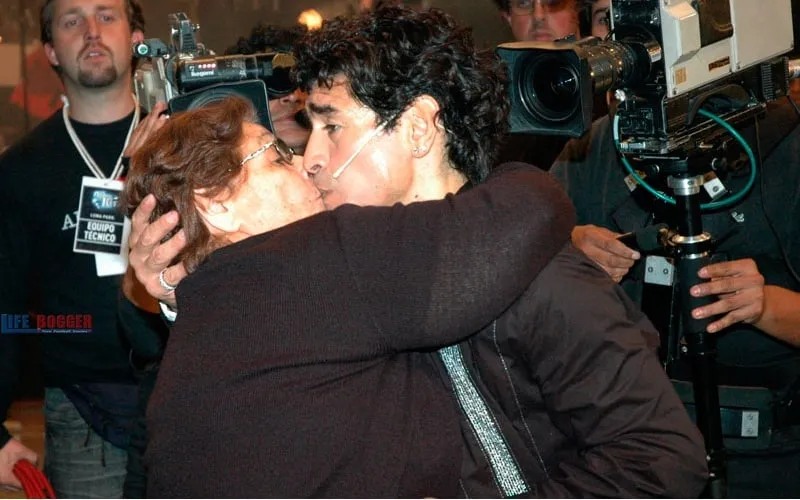
He was with her even to her dying bed. Maradona’s mother, in her prime, spent countless times visiting hospitals because of kidney issues.
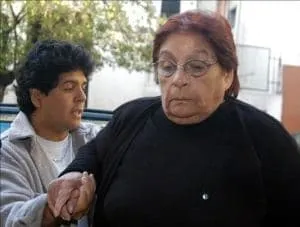
The Argentine legend’s mother passed away on Saturday, 19th November 2011, days after being taken into hospital for kidney failure.
Diego Maradona’s Siblings:
Raul Maradona: He is the immediate younger brother of Maradona. He played in Argentina for Boca Juniors, in Spain for Granada, and in Peru for Deportivo Municipal; he also played in Japan, Canada and Venezuela.
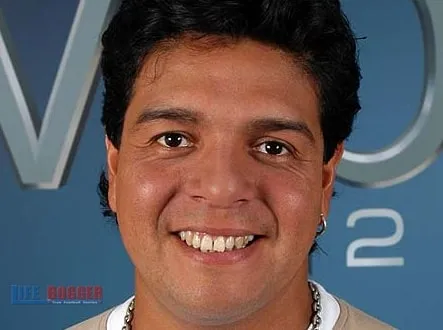
Hugo Hernán Maradona:
Another younger brother was born on the 9th of May 1969. He is also known as El Turco. Hugo Hernán Maradona is the one with a striking resemblance to his elder brother Diego.

He was once a coach for Argentina’s national football team and a former player. As a midfielder, he played for various clubs across South America, Europe, Japan, and Canada. He also represented Argentina as part of the U-16 national team.
Diego Maradona’s Sisters:
Diego Maradona has a total of 5 sisters, as you can see below.

The late Argentine Legend has three older sisters and two younger brothers.
Diego Maradona and Claudia Villafane Love Story:
Late Maradona married his longtime sweetheart, Claudia Villafane, on the 7th day of November 7th 1984.
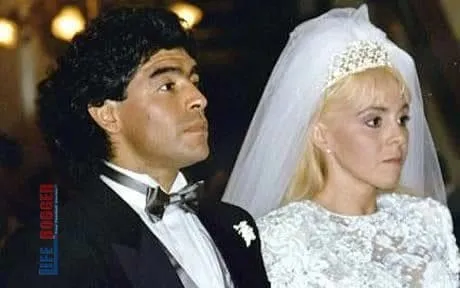
They lived together in love and harmony, with Claudia standing by Diego’s side through his most difficult years, offering unwavering support during his struggles.

The couple was blessed with two children, Giannina Dinorah and Dalma Nerea, who became the pride and joy of their family. Pictured below, Dalma Maradona is an Argentinean Actress and singer. She was born on 2nd April 1987 in Barrio Norte, Argentina.

Diego’s daughter, Dalma Maradona, began her acting career at the Hugo Midón Theatre Arts School. She went on to earn her degree in performance from Instituto Universitario de Arte.
She is best known for bringing to life Sofia in the children’s series Cebollitas.
His second daughter, Giannina Maradona, was born on the 16th of May, 1989. She was introduced to Sergio Aguero in 2008 by Diego Maradona, and both seemed to get along quickly. Giannina married Sergio Aguero in 2008, and their son Benjamin was born in 2009. The couple divorced in 2013.
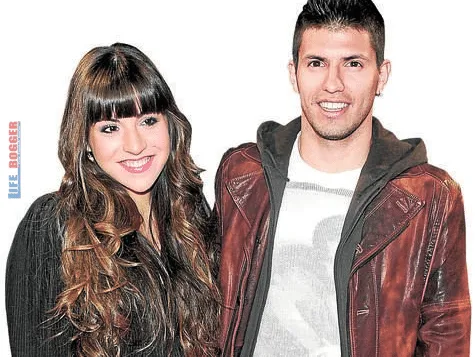
Diego Maradona and his wife Claudia Villafane was known to have married for 15 years and divorced back in 2004.
During their divorce proceedings, he confessed to having an illegitimate son, Diego Sinagra, who plays football in Italy (as of the time of writing).
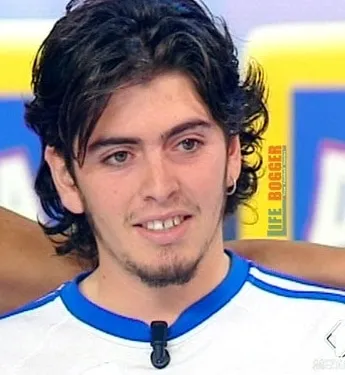
In 2013, he was also blessed with a son, Diego Fernando, from his long-term relationship with his ex-partner, Veronica Ojeda.
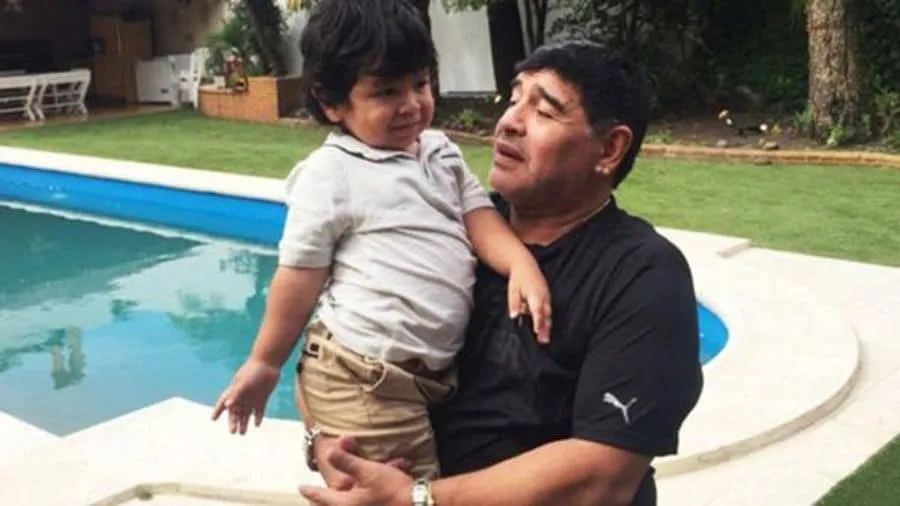
From the 1980s until 2004, he struggled with chronic drug addiction, which took a toll on his health and performance. Even after relocating to Cuba and attempting to follow a drug rehabilitation program, his situation did not improve. Tragically, in 2004, he suffered a major myocardial infarction due to a cocaine overdose, highlighting the severity of his struggles.
Maradona had two legally recognized children. He expressed a somewhat ambivalent attitude towards fatherhood, famously stating, ‘My legitimate children are just Dalma and Giannina. The rest of my kids are a product of my money and mistakes.

This fueled anger to his illegitimate son, Diego Sinagra, during a press conference talk.

Diego Maradona Biography Facts – Career Summary:
Much changed for him after his time with the Little Onions. At the age of 12, he was selected to play for Los Cebollitas, where his remarkable skills continued to impress the audience. By the time he turned 15, he had earned the opportunity to make his professional debut with Argentinos Juniors.

He led the Los Cebollitas to a 136-unbeaten streak, displaying his prodigious capability and talent.
Maradona was a short yet fearless midfielder renowned for his extraordinary talent. He possessed a unique ability to generate scoring chances, both for himself and for his teammates. With that, he led various club teams to numerous championships in Argentina. He seized the chance to lift his family out of poverty, a dream he was determined to achieve.
The pinnacle of his career came when he was part of the Argentine national team that won the 1986 World Cup. Throughout his international career, Diego faced relentless dirty tricks from opponents, yet he persevered.
During the 1986 World Cup in Mexico alone, there were 53 fouls against him. His performance there included two memorable goals in a quarter-final victory over England:
The first was scored illegally with his left hand, which Maradona later claimed was the work of “the hand of God”.

His second goal showcased not just skill but an extraordinary ability to weave through a swarm of defenders and find the back of the net without any supernatural assistance. Throughout his career, Maradona played in four World Cups, scoring an impressive 34 goals in 91 international appearances for Argentina. One of the most shocking moments came during the 1990 World Cup when Argentina suffered a surprising defeat at the hands of Roger Milla‘s Cameroon.
In 1983, Maradona made headlines with his transfer to Spanish club FC Barcelona for a world-record fee of $7.6 million. During his time there, he managed to stay focused and helped the team win the Copa del Rey and the Spanish Super Cup. His two years at Barcelona were highly successful, with 38 goals in 58 games. However, off-field issues with staff and teammates led to another record-breaking transfer to the Italian club Napoli for $10.5 million.
Despite his undeniable talent on the field, the emotional Maradona became equally famous for his controversial life off it. During his time playing in Spain in the 1980s, Maradona developed a cocaine addiction, which ultimately led to a 15-month suspension after he tested positive for the drug in 1991. His struggles continued, and three years later, he faced another suspension, this time for testing positive for ephedrine during the World Cup.
Retirement:
Maradona spent the last years of his playing career in Argentina, but his physical abilities had diminished due to a series of injuries and the challenges he faced in life. He announced his career retirement on the eve of his birthday in 1997.

Post Career Life:
The problems that plagued Maradona during his playing career continued after his retirement.
Around July 1998, Maradona received a suspended sentence of two years and ten months for shooting journalists with an air rifle in 1994.
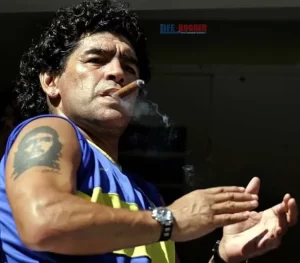
Drug intake became worse after his retirement. Maradona was hospitalized for heart problems in 2000 and 2004. That year 2004, when hospitalized, he had to use a respirator to breathe properly.
Admitted to a private clinic in Uruguay after suffering a heart attack. Is invited to recuperate in Cuba by Fidel Castro, and spends much of the next four years in the country.
Diego Maradona Obesity Issues:
Again, after retirement, his drug and alcoholic lifestyle became uncontrollable. This behaviour led him to a weight of 267 pounds. This was clearly an obesity problem. Many who saw him then referred to his belly as “The Belly of Budha”.

With the help of surgeons in Cartagena, Colombia, a gastric bypass operation was done. This surgery help the portly star shed 50kg from his current weight of 121kg. This happened in 2005.
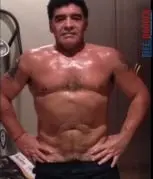
After the surgery, some criticism was raised among the medical community regarding the big risk they just incurred.
A risk not only for the patient but also for the hospital’s prestige. Diego Maradona could have died in the process.
Besides the risk, some say they approved the surgery due to Diego’s rebellious nature, saying he won’t be missed so much if he had died in the process.
Diego Armando’s impulsive personality didn’t help to maintain his diet and post-surgery care, so he gained back part of the lost weight.
Player and Goal of the Century Award:
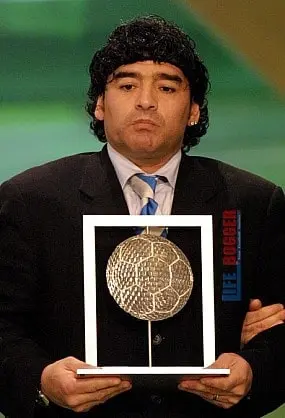
As the new millennium arrived, FIFA decided to award the title of Player of the Century. An internet poll conducted by the organization named Maradona as the top player of the 20th century, sparking significant controversy. Maradona responded to the news by stating, ‘The people voted for me. Also, some people wanted me to share the prize with Pelé. I’m not going to share the prize with anybody.’ This marked the beginning of his longstanding rivalry with Pelé.
Additionally, Maradona’s second goal against England was voted ‘Greatest Goal of the Century’ during a 2002 online poll conducted by FIFA. In that unforgettable moment, he received the ball in his own half and skillfully dribbled past five English players in just 11 touches, covering more than half the field to score the goal.
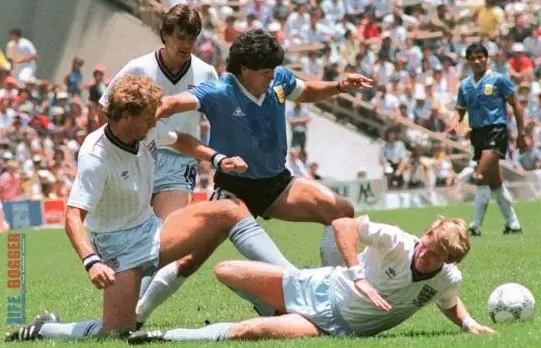
In honor of Maradona’s extraordinary skill and brilliance, the stadium authorities erected a statue of him scoring the iconic ‘Goal of the Century.’ The statue was placed at the entrance of the stadium, ensuring his legendary status would be remembered by future generations.
The Argentine Coach:
In 2008, Maradona was appointed as the head coach of the Argentine national team, marking a significant return to the sport in a new role. His appointment generated excitement among fans, as they looked forward to seeing the legendary player lead his country once again.
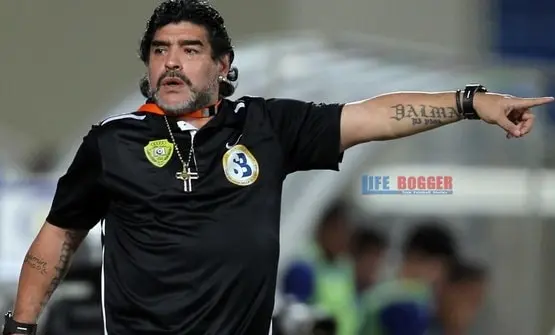
Despite having a talented squad led by Lionel Messi, a Baller who was widely regarded as one of the world’s best players in that World Cup tournament held in South Africa, the Argentine team faced a disappointing exit, suffering a 4-0 defeat to Germany in the quarter-finals. As a result, Maradona’s contract was not renewed.
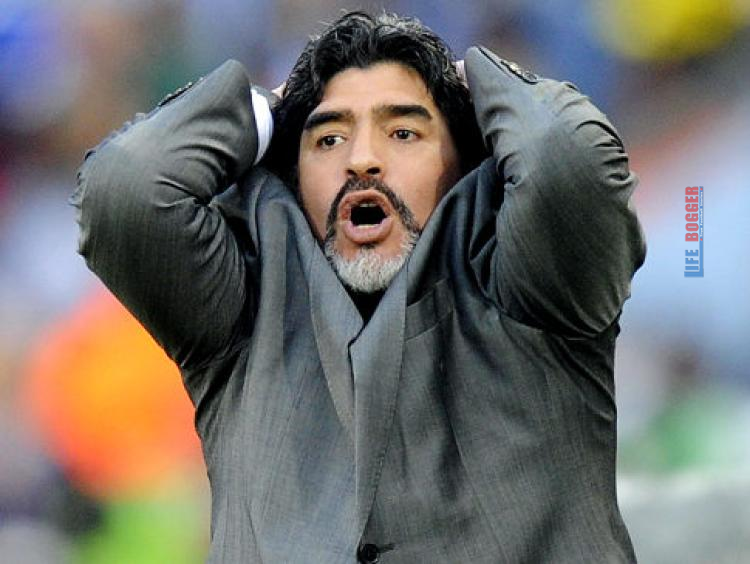
Despite the public disappointments, Maradona remains a beloved figure in Argentina, celebrated as a native son who rose from truly humble beginnings to achieve the pinnacle of stardom on the international stage.
Diego Maradona Tattoo Facts:
The late Argentine Legend joins the list of illustrious Argentine footballers, the likes of Mauro Icardi and Lautatro Martinez, known for their love for tattoos. Before his death, Maradona had five tattoos, including the names of both his daughters “Gianinna and Dalma” on each forearm. Diego also has a dragon tattooed on his left leg as seen in the picture below.
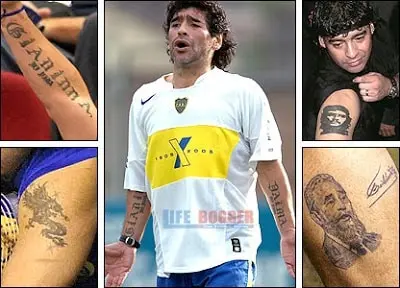
Maradona has a tattoo of Argentine Marxist revolutionary Che Guevara on his upper right arm. He often spoke of his deep admiration for Guevara, saying, “I carry him both on my arm and in my heart. I learned his story, grew to love him, and believe I understand the truth about who he was.”

Maradona also has a portrait of Fidel Castro, the former Prime Minister of Cuba, tattooed on his left leg. He once remarked,
“Meeting him was like touching the sky with my hands. What he did for me is beyond words. Along with God, he’s the reason I’m still alive.”
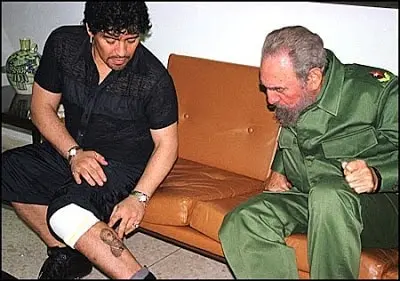
Diego Maradona Nicknames:
Diego Maradona was adorned with nicknames during his illustrious career, but the most original is “Barrilete Cósmico” in English, “Cosmic Kite”.
The name was given to him by legendary Uruguayan radio commentator Victor Hugo Morales and was first heard by the Argentine public in 1986, just after he scored that goal against England.
“Cosmic Kite. What planet have you come from?” he screamed. Years later, the commentator said he had believed Maradona’s dribbling was so unpredictable that for opponents, it must have been like chasing a kite in the wind.
Diego Maradona Biography – Love and Hatred for Napoli:
Diego Maradona was most famous for his time at Napoli. He came to Napoli after he fell out of favour with the FC Barcelona club president, Jose P. Luis Nunez.
Maradona was transferred for a record $10.48 million, making him the only player in football history to have commanded a world record transfer fee twice.
Upon his arrival, Maradona was welcomed by 75,000 fans when presented on July 5, 1984, as a Napoli player. His arrival raised the hope of the fans, and they believed that the saviour had arrived.
He elevated the club to new heights in its era, and Napoli won its maiden Serie A Italian Championship in 1986-87. The fans adored Maradona, and the celebration carried around the clock for a week.
Maradona, one of the Greatest one-footed players in the game’s history, played a key role in helping Napoli win the Coppa Italia in 1987, the Italian Supercup in 1990, the UEFA Cup in 1989, along with the Serie A championship. His influence was so profound that many newborns in Italy were named ‘Maradona’ in his honour.
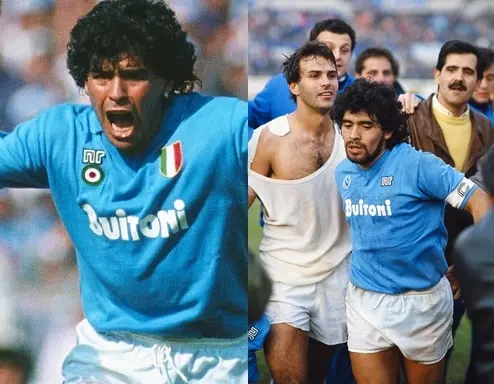
His problems at Napoli started when he started missing games and taking drugs. First, he was fined $70,000 in fine by his club for missing games and practices because of stress. His cocaine use continued and was also linked to Camorra, the criminal organization.
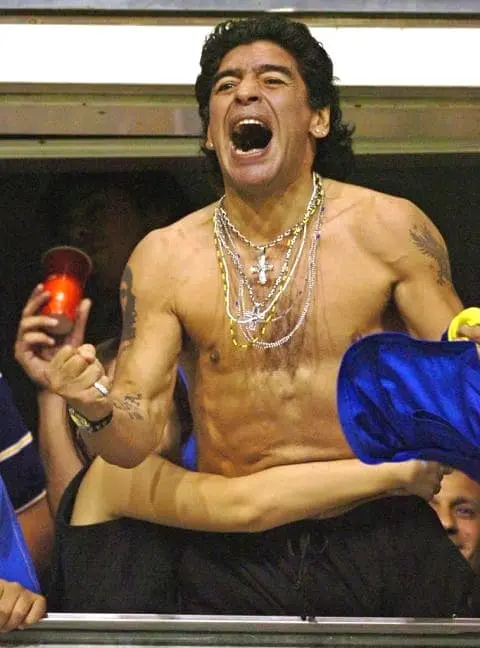
He faced a 15-month suspension after testing positive for cocaine, which led to his release from Napoli in 1992. In his honour and for his achievements, his jersey No. 10 was retired by Napoli.
In 1996, Maradona candidly said,
“I was, I am, and I always will be a drug addict. Anyone who gets involved with drugs has to battle it every single day.”
He left owing Napoli a little bit of money to the Italian taxman. Officials said in 2009 that Maradona owed them €37 million. However, more than half of this is interest on the original debt.
Diego Maradona Football Idols:
He was inspired by Brazilian Rivelino and George Best of Northern Ireland while growing up.
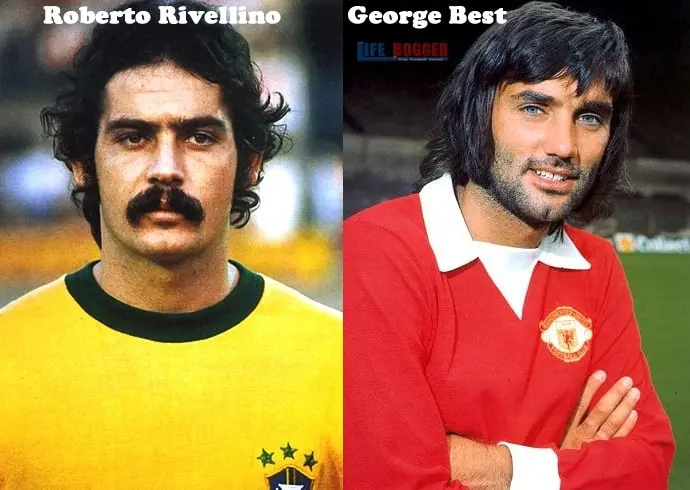
Diego Maradona admired for their courage, outstanding achievements and noble qualities.
Diego Maradona Hand of God Referee:
Ali Bin Nasser was the referee who officiated the game and blew the whistle when Maradona scored the “Hand of God Goal”. Maradona, after 29 years, visited Ali Bin Nasser.
This interesting visit happened on August 17th, 2015. Maradona went all the way to Tunisia and paid tribute to his referee hero and presented a signed Argentine Jersey to him.
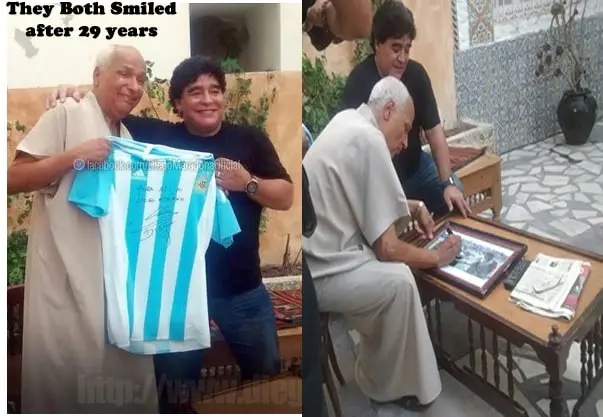
It was Ali Bin Nasser who stood holding the ball in the picture below.

Meeting his ‘eternal friend’ and giving him a signed Argentine shirt meant a lot to him.
Diego Maradona kissed and hugged the man after his heart. They both smiled after 29 years.
This had brought heavy criticism among England Football pundits and supporters. Their Hatred which appeared to hand softens for both pairs, suddenly jumped.

Tunisian referee Ali Bin Nasser when asked why he did that, claimed his decision to award the goal was influenced by Dochev, the linesman.
“I was waiting for Dochev to give me a clue about what had really happened, but he didn’t signal for a handball,”
Bin Nasser said. Although some tried to place all the blame on him, the responsibility was ultimately shared between both officials.
Diego Maradona Hand of God Linesman:
The Bulgarian linesman who failed to report Diego Maradona’s infamous “Hand of God” goal, Bogdan Dochev, passed away at the age of 80. Dochev spent much of his life reflecting on why he didn’t spot Maradona’s handball during the 1986 World Cup.
Reflecting on the incident, Dochev said,
“Although I immediately sensed something was off, back then, FIFA didn’t allow assistants to discuss decisions with the referee. If FIFA had appointed a European referee for such an important match, Maradona’s first goal would have been disallowed.”
He also previously shared his frustration, stating,
“Diego Maradona ruined my life. He may have been a brilliant footballer, but he was a small, foolish man, lacking both height and wisdom. The instructions from FIFA were clear: if a colleague had a better view, I had to respect his judgment.”

Diego Maradona Biography – Link with Gadaffi:
In 2003, Maradona was appointed as a technical consultant by Al-Saadi, the third son of Muammar Gaddafi. Al-Saadi, at that time, was playing in the Serie A for Perugia Calcio.

Maradona’s Link with Gadaffi’s Family- Untold Story.
Church of Maradona:
In today’s world, athletes are often idolized and placed on a pedestal for all to admire. But do they truly deserve to be seen as gods? While they are undoubtedly at the top of their game, treating them as objects of worship is a different matter entirely.
Did you know? In 1998, Argentine fans founded the “Church of Maradona” in Buenos Aires. This organization takes fan devotion to a new level, as its followers literally worship Maradona’s “divine” left foot, which dazzled on the pitch.
With over 120,000 members, the Church of Maradona venerates the retired Argentine football legend as a deity. The church has even created its own Ten Commandments, a version of the Lord’s Prayer, and religious texts, all centred around Maradona’s legacy.
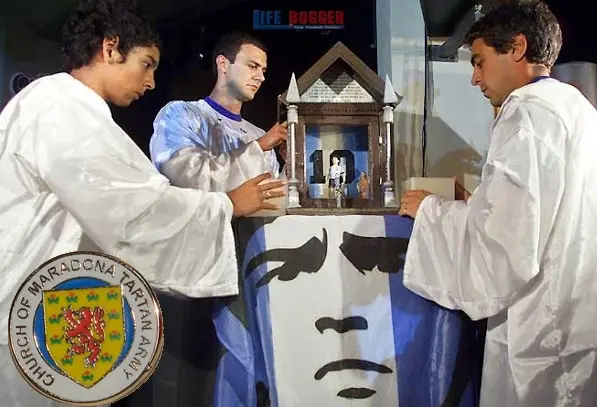
Church of Maradona Alter.
The followers of the Church of Maradona even have their own version of the Lord’s Prayer:
“Our Diego Maradona, who art on earth, hallowed be thy great left foot, thy magic come, thy goals be remembered.”
For these devoted followers, Maradona’s life is deeply intertwined with their own. His struggles, including his constant battle with drug addiction, profoundly affected the entire group.
The Church has even redefined the calendar, marking time as “AD” — After Diego. For example, 2016 in the Church of Maradona is considered 56 AD, symbolizing 56 years after Maradona’s birth.
They also celebrate Maradona’s birthday with the same reverence as Christmas, treating it as a holy event in honour of their beloved “god.”
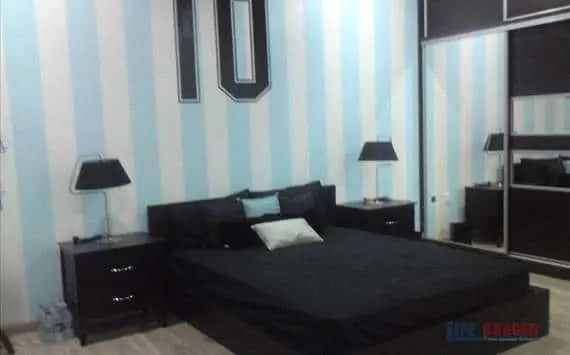
Church of Maradona member’s bedroom.
The followers of the Church of Maradona adorn their trees and bedrooms with decorations themed around Maradona and the colours of the Argentine flag. The church has established ten guiding codes that each member must adhere to in order to uphold the legacy of this unique establishment.
Below are the Maradona Ten Commandments;
- You must have a Church of Maradona Alter in your home Church of Maradona’s Alter.

- You must have a Church of Maradona altar in your home.
- Love football above all else.
- Declare unconditional and heartfelt love for Diego and the beauty of football.
- Defend the Diego Maradona Argentina shirt.
- Spread the news of Diego’s football miracles.
- Honour the temples where Diego played and his sacred shirts.
- Don’t proclaim Diego Maradona as a member of any single team.
- Preach and spread the principles of the Maradona church.
- Make Diego as part of your middle name.
- Name your first son, Diego.
Diego Maradona Bio – War of Words Against Pele:

A rivalry of words has simmered between Maradona and Pelé ever since Maradona won the Player of the Century award. Their exchanges have been quite pointed over the years.
During Maradona’s time as the national team coach, Pelé remarked,
“It’s not Maradona’s fault; it’s the fault of those who put him in charge.” In response, Maradona fired back, suggesting, “Pelé should return to the museum and stay there.”
Attacking Critics:
- After smashing a photographer’s camera for being intrusive, Diego said, “I did it with the hand of reason.”
- Maradona has been a passionate supporter of Lionel Messi, always standing up for him in the face of criticism. On July 2, 2010, he voiced his endorsement by stating, “Anyone who claims he didn’t have a great World Cup is an idiot.”
- 2010 World Cup – Despite this terrible defeat, the team, which had the likes of Messi, Ángel Di María and Sergio Agüero, managed to get through to the tournament.
To his critics, Maradona retorted. “To those who did not believe: now s**k my d**k – I’m sorry ladies for my words – and keep on suck**g it. I am either white or black.
FIFA wasn’t terribly happy about this foul-mouthed outburst. They slapped a two-month ban on him.
- FIFA Attack- Maradona got his own verbal revenge against FIFA when he complained vociferously about the new ball to be used in the 2010 World Cup tournament in South Africa.
He said- “I would ask all Fifa directors to stop talking about me and to start working on having a proper football. This ball is useless. It’s impossible to control.”
- 1998 World Cup- Back in 1998, he said, about the World Cup of that year.
“The players have all got square feet. They’re like Robocops; they need more lubricant than a massage. I can’t imagine how the tournament could be any worse.“
Cause of Diego Maradona’s Death:
Football legend Diego Maradona passed away at the age of 60 on November 25, 2020, after suffering a heart attack. His death was seen by many as a tragic loss at an early age.
At the time, he was at home in Tigre, recovering from brain surgery he had undergone earlier that month. Leading up to his death, Maradona was dealing with a blood clot in his brain and had been expressing feelings of low spirits and fatigue. His passing left a significant impact on fans and the football community around the world, mourning the painful loss of one of the sport’s greatest icons.
